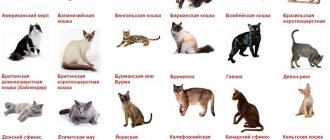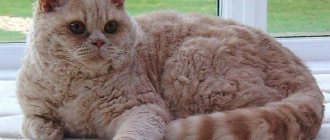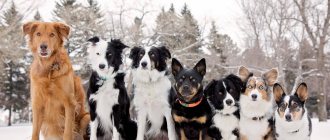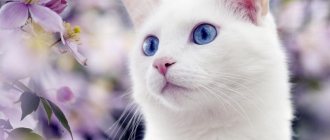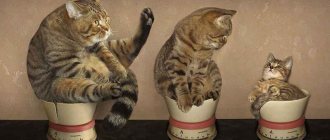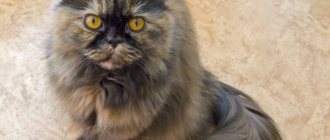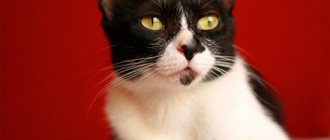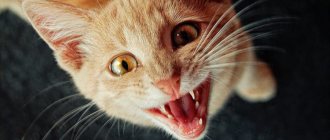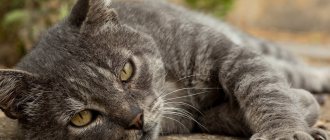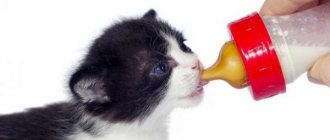Every cat owner considers his own pet to be the best, most beautiful and unique. The owner of a purebred kitten has reason to be proud of his aristocratic origins and corresponding pedigree.
Those who have an ordinary mongrel dog slumbering at their side can only be consoled by its devotion and wonderful character. However, the owner has the opportunity to classify his mustachioed cat independently as a breed.
It can be determined by the appearance of the animal. The dimensions of a cat, the size of its ears, the length of its paws and tail, as well as the texture and color of its fur can tell a lot to an inquisitive observer.
How much does a Turkish Angora cost?
In Russia, a non-show Angora kitten can be bought for 7,000 - 8,000 rubles. The most expensive are breeding specimens that will be used by breeders in the future to breed the breed, as well as pets that meet the most stringent standards and are suitable for participation in exhibitions.
Interesting materials:
What antibiotic ointments are there? What media are there? What international environmental organizations are there? What are the disadvantages of the Internet? What are the Easy models? What Lamborghini models are there? What seas are there on the globe? What cartoons are Spider-Man? What museums are there at VDNKh? What are the national and international organizations?
The main differences between purebred pets and domestic ones
Scientists have proven that domestic cats have a common ancestor - the steppe cat, which still lives in North Africa . About 200 cat breeds have been registered by felinological organizations. All of them are the result of painstaking work of breeders and have clear standards. The shape of the head, muzzle, eyes, ears, length of fur, limbs, tail, body, color and character are taken into account.
Pedigree cats have documents that confirm their belonging to the breed . They record the names of its three generations and color features. The meaning of an animal's thoroughbred is that when purchasing, the owner will know exactly what character the animal has, what health nuances need to be paid attention to, and how to care for it.
For example , the Siamese cat is known for its loud meowing and vindictiveness, based on this, the future owner knows what he will have to face. Sphynx cats require special skin care and nutritional control due to their excessive appetite.
There are mixed breeds of cats with a whole bunch of genetic pathologies, but at the same time they have an attractive appearance and an easy-going disposition. All this must be taken into account when choosing a kitten - the necessary information can be obtained from the owner of the nursery. This is why experts advise contacting specialized nurseries so as not to literally buy a “pig in a poke.”
If you come across a baby not from a nursery, but, say, it was given to you as a gift, or you picked it up on the street, you can try to determine the breed yourself. To find out what breed a cat is, you need to carefully examine the animal, determine its striking features , and then study the appropriate breed standard.
You can go the simple route and contact a specialist who will tell you how to recognize a cat’s breed and point out its distinctive features. But most often on the streets there are outbred cats that only vaguely resemble their purebred relatives . Such animals often have an elongated muzzle and body, a thin build, medium-length gray, brown, black or tricolor hair, muscular paws with long claws, round eyes, and an energetic tail that expresses the entire range of emotions of the animal. Yard murkas do not exceed 50-75 cm in length and weigh between 2-6 kg.
In fact, purebred aristocrats are not much different from barn cats, so determining the breed by eye often causes difficulties. Most look closely at the external characteristics and compare them using pictures on the Internet.
However, professionals assure that appearance is not the most compelling argument in favor of an animal’s thoroughbred . The cat's habits, character, and temperament are important here. It takes a long time for outdoor cats to get used to the litter box and they don’t realize that they shouldn’t tear up the sofa or nibble on the flowers on the windowsill. Owners have to put a lot of effort into raising their pet and instilling good manners in it. Pedigree cats are another matter! They have the habits of an intellectual at the genetic level.
How to recognize a cat's breed by external differences
Studying the appearance features will help determine the cat's breed .
Ears
The shape of the ears is a striking distinctive feature indicating belonging to a particular breed.:
- forward-curved ears are characteristic of the Scottish Fold and Highland Fold;
- turned back - only in the American Curl;
- small, low-set, close to the head - in the Highland Fold;
- medium-sized ears, devoid of vegetation with drooping tips - in the Ukrainian Levkoy;
- large, wide at the base, open, with smoothly curving tips - in the elf;
- triangular, pointed, with tassels at the tips - in the Maine Coon;
- hanging ears covered with curls of hair - the poodlecat;
- disproportionately large in relation to the head - in Abyssinians and Orientals.
Short tail
A short tail is a congenital trait that defines the breed:
- American and Kurilian bobtail;
- pixie bob;
- toy bob;
- Kymrik.
Toy Bob
Tailless breeds - Japanese Bobtail and Manx cat.
Reference. Cats of the eastern group of breeds have long and thin tails.
Little paws
In nature, short-legged cats are rare.
All breeds with short limbs were bred artificially:
- bambino;
- Dwelf;
- munchkin;
- minskin;
- Napoleon;
- skookum.
Little ones
Dwelf
Among the representatives of exotic breeds there are also completely small or even tiny cats. For a better understanding of their size and weight, we also present them in the table:
| Breed | Length at withers | Weight |
| Lambkin | From 17 to 20 cm | From 2 to 5 kg |
| Bombino | From 17 to 20 cm | From 2 to 4 kg |
| Skookum | From 22 to 25 cm | From 1.5 to 3 kg |
| Munchkin | Up to 20 cm | From 1.8 to 2.7 kg |
| Dwelf | From 20 to 25 cm | Up to 3.5 kg |
| Singapore | From 18 to 22 cm | Up to 3 kg |
| Minskin | Up to 20 cm | From 2.5 to 3 kg |
Lambkin
Bombino
There are similar differences between male cats and female cats. Cats are larger by several grams, and sometimes even a kilogram. The table shows the minimum and maximum sizes and weights for both genders.
How to determine cat breed by size
Pedigree cats are divided into 2 groups based on their body type.:
- Animals with a large, rounded head , a flattened nose and a stocky body. This is the body structure of Persians and exotics.
- Animals with a wedge-shaped head , an elongated and oblong muzzle, a long graceful body and limbs. Angora, Siamese, Balinese, longhair and oriental shorthair cats fit these characteristics.
As for the weight of purebred cats, it varies from 2 to 20 kg . The body length is 40-80 cm.
Big cats
List of giant cats:
- Ashera;
- British;
- Egyptian Mau;
- Kurilian and American bobtails;
- Maine Coon;
- Norwegian Forest Cat;
- pixie bob;
- ragamuffin;
- ragdoll;
- Siberian;
- Turkish van;
- chausie;
- chito;
- Chartreuse.
Asherah
Little cats
List of miniature breeds:
- bambino;
- Dwelf;
- Kinkaloe;
- lambkin;
- munchkin;
- minuet;
- minskin;
- Singapore;
- skookum.
Lambkin
Furry Pet Identification
We all know very well that domestic cats can be purebred, non-pedigreed or simply “Moggy”. Purebred pets are distinguished by certain qualities, external features, and characteristics that distinguish them from others. As a rule, they are bred by breeders, strictly observing standard qualities. This includes the size of the animal, color, exterior characteristics of the body, eye color, length of fur, tail, etc.
But it is very difficult to determine a breed by just one criterion; it is important to correlate at least several necessary qualities
Based on a set of certain exterior characteristics
Cats of different breeds have both distinctive and similar external features. Therefore, by correctly assessing the appearance of the animal, you can at least approximately understand who is in front of you: a cat of some breed or an ordinary “moggy”. How to determine the breed of a cat, knowing its external features? We invite you to consider the most interesting and most distinctive features that will be inherent and visible in both an adult cat and a kitten.
| Part of the body | Peculiarity | Possible breed |
| Body and body structure |
| Exotic or Persian breed; Savannah, Maine Coon, Norwegian Forest. |
| Ears |
|
|
| Tail | the tail is short. | |
| Paws | short, squat. | Munchkin. |
| Wool | short but curly coat; long and curly; long and straight; short smooth. |
Ashera, Abyssinian. |
| Color | dark color with white paws and muzzle; solid blue or silver color without spots; sand color; wild coloring, presence of spots, stripes. | Snowshoe, Burma, Ragdoll; Korat, Russian Blue, Scottish Fold, Chartreuse, Nibelung; Abyssinian cat, Somalia, Havanabrown, Tiffany-Chantilly; Siberian, Bengal, Maine Coon, Egyptian Mau, Savannah, Safari, Serengeti. |
According to behavioral characteristics
Behavior and habits are another way to find out the breed of a cat. The fact is that with the correct “pure-bred” crossing, all character traits are inherited. Therefore, cats of the same breed have similar characteristics. For example, cats of the Russian Blue breed are monogamous and handed over to their owner. Siamese cats, Savannah cats, Asherah cats, Abyssinian cats and others are endowed with sharp and even slightly wild habits.
The Persian cat, for example, is easy to recognize by its behavior, as it is docile and friendly. Doesn't like to be alone and will follow you around. They become very attached to humans and love to be held. But these cats are more exotic breeds, for example, the Turkish Van is not very accepting of communication, but loves to swim. Self-sufficient, but affectionate, very smart and reserved, even kittens of the Maine Coon and Egyptian Mau breeds.
By photo
To recognize a cat’s breed from a photograph, you need to know very well the main distinguishing features and at least have a little understanding of felinology. Otherwise it will be difficult, but quite possible. Look carefully at the photo of a cat or kitten, highlight some of its most remarkable features and compare it with the description and suitable parameters of different breeds. If there are similarities, you should assume that this is the representative in front of you. Of course, the most reliable way is to seek advice from a specialist.
Short legs
Oddly enough, “short legs” is a sign of thoroughbred pets, but all cats with similar limbs were bred exclusively artificially:
Munchkin
short straight legs (the hind legs may be slightly longer than the front ones), a medium-sized body with well-developed muscles, a thick neck and a wide wedge-shaped head, short or long hair.
more details
Skookum
skokum
short but strong legs (the front ones are slightly shorter than the hind ones), a compact and dense body with rounded contours of the head and a long tail of medium thickness, curly hair (can be short or long).
Napoleon
neat short paws, a small but strong body with massive bones and a long tail, a rounded head with a flattened muzzle and huge round eyes separated by a short nose, short or long, but always thick hair.
Bambino
short but muscular legs, a stretched oval-shaped body with a wide chest and a long thin tail, wide-set large ears (slightly tilted forward) located on a medium-sized head, a visible lack of hair (although light corduroy fluff is allowed).
more details
Minskin
short legs (of the same length below and above the knee joint), a rounded head with large, open and seemingly “alert” ears, thick and dense, but short hair growing in islands (on the head, ears, limbs, tail) almost on the “bare” body
more details
Tags
what cats and such cats shouldSiamese cat Abyssinian cat Oriental cat Balinese cat Manx cat Cymric cat all cats with domestic cats obvious cats are breeds of cats significantly domestic cats are valid and kittens the conclusion of which dock which include some kittens recognize which tails the surface of which is covered on which special color in which each cat features color and Siamese color Siamese color cotem color on the main color. main color on the main color.
dogfacerodents
Mr. Cat recommends: Online locator
Today, in the age of the ubiquitous Internet, to determine or clarify the breed of a pet, you can turn to “online identifiers”.
These virtual assistants are tables that systematize the breed characteristics of a wide variety of cat representatives. Simply by answering the questions posed using logical chains, you can determine whether the animal is purebred and which group it belongs to.
It should be remembered that these determiners are not an official expert; according to their estimates, it is impossible to obtain a pedigree for a cat. They cannot give a 100% guarantee that the result will be correct.
In this case, it is advisable to evaluate an adult animal; it is impossible to test a newborn here. The kitten needs to mature for at least six months in order for its breed characteristics to appear.
How to determine the breed of a kitten
It is extremely difficult to independently determine the breed of a kitten , since the distinctive features at this age are poorly expressed. In addition, the characteristics of babies may change as they grow older. For example, fold-eared kittens have erect ears at birth, which droop after a few months.
Experts advise paying attention to the constitution of the body, the structure, length and color of the coat, the color of the iris, and the shape of the ears . If you have a munchkin in front of you, the baby’s legs will be short. If this is a small Canadian Sphynx, then its skin will be bare. And in the Ukrainian Levkoy the whiskers will be curled even with partial presence of hair.
Russian Blues and British Blues are similar in color and coat structure, but have differences in body structure. British cats are heavyset and large, Russian blue cats are more graceful and elongated.
Important! Even if a kitten fully complies with the breed standard, without supporting documents it is considered out of breed.
Eyes
You can tell what breed a cat is by looking at its eyes. This is difficult to do, because many breeds have the same eye color. Therefore, you need to pay attention not only to the color, but also to the shape and location of the eyes so that the result is correct.
For example, British cats are the only ones with orange eyes . A cat of the same breed, among other things, is endowed with strabismus. The Turkish Angora and the Turkish Van have another, but no less striking feature - eyes of different colors.
© shutterstock
Head
The structure of the skull and the general appearance of the head are the hallmarks of a purebred cat. It cannot be said that each breed has its own distinct characteristics regarding the skull. To determine the breed by the appearance of the head, it is necessary to study all the values and compare them with the standards adopted for outbred cats.
If the differences are significant, then we can say with a high degree of confidence that the cat has a certain breed . It will be possible to tell what breed the pet is after the cheeks, cheekbones, nose, forehead, profile, bite, chin and nasal pads are assessed.
How to find out a cat's breed by coat color
Aristocratic cats compare favorably with ordinary yard cats by their variety of colors . For the latter, it is often simple - tricolor, spotted and striped, one- and two-color.
Breeders worked on the color of purebred cats, achieving interesting colors.
Siamese
The Siamese color or color point is one of the most beautiful and spectacular . It is characterized by dark areas on the animal's face, paws, ears and tail. The body is light in color.
Initially, only Thai and Siamese cats had this color, but as a result of breeding work, the following breeds acquired the Siamese color :
- Balinese;
- Burma;
- Himalayan;
- Neva Masquerade;
- Persian;
- ragdoll;
- snowshoe.
There are several variants of point colors:
- blue point - silver-blue;
- caramel point - gray-beige;
- cream point - beige-amber;
- lilac point - pink-blue;
- red point - rich apricot;
- seal point - delicate cream;
- fan point - pale cream;
- cinnamon point - reddish brown;
- chocolate point - brown chocolate.
Only a specialist can identify point colors . Kittens are born white and the markings appear after a few days.
Blue
The blue color is the same as solid gray, an integral characteristic of the British Shorthair cat . The color is determined immediately at the birth of the babies.
Shades of gray are found in these breeds:
- korat;
- Maine Coon;
- Nibelung;
- oriental;
- Russian blue;
- chartreuse;
- Scottish.
Sand
Sand color or sorel is the least common color and defines the breeds - Abyssinian and Somali cats . The fur is unevenly colored: the main part is bright red (copper), and the tip is ticked (dark, chocolate brown).
Abyssinian cat
Wild
Wild natural color or tabby is characterized by the presence of clear spots, stripes, rosettes , making domestic cats small copies of leopards and cheetahs. This color is observed in the Bengal, Egyptian Mau, Siberian cat, Asherah, Safari, Serengeti, Kurilian bobtail, Ocicat, Caracat, Kanaani. The color is characteristic of hybrid breeds and is determined instantly.
Mackerel tabby color
Brown
Brown or chocolate uniform, monochromatic coat color is typical for cats of royal origin and is almost never found in the wild.
The breeds can boast of this color:
- Abyssinian;
- British;
- Burmese;
- Havana Brown;
- Persian;
- Chantilly Tiffany;
- Scottish.
How to recognize a cat's breed by its special coat
The structure of the coat varies greatly among different breeds . Cats are mostly divided into short-haired and long-haired.
Long, thick and straight coat with dense undercoat:
- Angoras;
- Burmese;
- British and Scottish longhair;
- Himalayan;
- Maine Coon;
- Neva Masquerade;
- Norwegian forest;
- Persian;
- ragdoll;
- Siberian;
- Somalia;
- Turkish van.
The Bohemian Rex, Selkirk Rex, Laperm have long and wavy fur
Short with tight curls in the Cornish Rex, Devon Rex and German Rex.
a coarse and curly coat .
Bald breeds:
- bambino;
- Dwelf;
- Don and Canadian sphinxes;
- kohanu;
- minskin;
- Peterbald;
- Ukrainian Levkoy;
- elf.
Reference. Rex cats have pleasant and soft fur, reminiscent of astrakhan fur.
Sphinx
